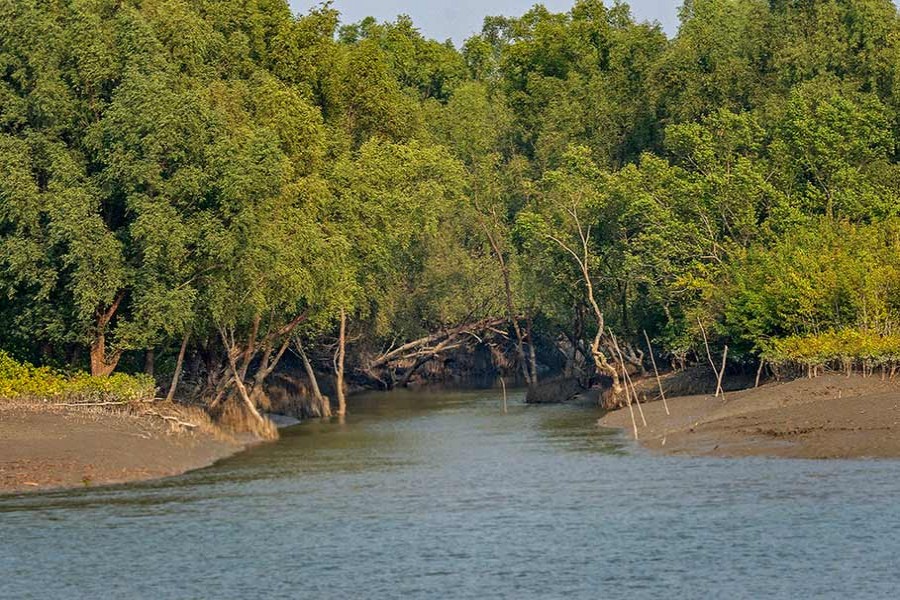I have come across an interesting piece of report in the online version of The Financial Express (published on June 07 2019) on the economic valuation of carbon stock in the Bangladeshi part of the Sundarbans mangrove forests and the prospects of earning a money by selling that stock by the country.
The report's title is 'Sundarbans has Tk 188 billion carbon reserve: Survey', and can be found here: https:// thefinancialexpress.com.bd/trade/sundarbans-has-carbon-reserve-worth-of-tk-188billion-survey-1559889866?fbclid=IwAR3Sxl006AR0WqPv5G1Zv76MbX5pVRY6zsnib9viISx-2mOuirsDQwPMY(last accessed on 8 June 2019 at 1.42 am Bangladesh time).
The issue is indeed important. However, I found the report flawed and highly misleading as explained below.
To me this report presents a classical example of misconception between the carbon sequestration and carbon stock. Carbon stock and carbon sequestration are different things, and the report seems to have mixed them up, completely.
To set the things straight, let me first explain the terms carbon stock and carbon sequestration in the context of forest ecosystem. Forest carbon stock is the amount of carbon that has been removed from the atmosphere by a forest ecosystem and is stored in its above and below ground living biomass, soil, dead wood and litter. On the other hand, the carbon sequestration is the increase in carbon stock in that forest ecosystem during a certain period of time. This is typically measured as the difference in carbon stock between the start and end of that time period.
The whole carbon market business, or carbon trading as commonly known, works on the principle of additionality, i.e. how much additional carbon can be removed from the atmosphere in a certain period (one year, five years, ten years and so on) e.g. by natural forests or plantations, not what they already store (i.e. carbon stock). Thus, it is the carbon sequestration, i.e. not the carbon stock, which can be sold as carbon credits (usually measured in tonnes or megagram of carbon or CO2) to the emitters who are looking for offset.
The report repeatedly mentions the sale of carbon stock of the Bangladesh part of the Sundarbans in the international markets, and earning money by the country in the process. The problem is that such sale is simply not possible. This is because the carbon stock itself does not fulfils the criteria of additionality, and hence cannot be traded in the market. Therefore, there is no prospect of earning money by selling carbon stock.
For carbon price in total value calculation, the report has referred to certain 'Chicago carbon market', which does not exist. If it meant Chicago Carbon Exchange, that too ceased its operations in 2010.
The report's reference to the Kyoto Protocol is also incorrect as the Clean Development Mechanism (CDM) under this protocol allowed the sale of carbon sequestration from plantations (afforestation and reforestation) only, not natural forests like the Sundarbans. Moreover, REDD+ (short for, Reducing Emissions from Deforestation, Forest Degradation and Sustainable Forest Management), an international mechanism developed by the United Nations that Bangladesh is implementing along with many other developing countries in the world usually works bilaterally. This means under REDD+, a donor (be it multilateral like the World Bank or bilateral like USAID) pays money to a developing country for avoiding carbon emissions or sequestering carbon by conserving and/or sustainably managing its forests. Largely because of bilateral nature of the mechanism, the carbon credits from REDD+ are not allowed to be sold in the international carbon markets.
The above leaves us with only one more option, which is the voluntary carbon market. Theoretically, there is a scope of selling credits originated from carbon sequestration, not carbon stock, of the Sundarbans mangrove forests in the voluntary markets. However, requirements for entering such markets are very stringent, and the Bangladeshi Sundarbans does not apparently qualify under its current management regime.
In short, the sale of the Sundarbans' carbon stock in international markets and earning any money from that sale by Bangladesh are simply day dreams!
Sepul Kanti Barua holds a Doctor of Science degree in Forest and Climate Change Economics from Helsinki University, Finland, and was a visiting Doctoral Research Fellow at Yale University, USA. Dr Barua currently works as a Senior Consultant in NIRAS International Consulting, a multinational development consultancy, being based in Helsinki. Prior to joining NIRAS he worked as an Environmental Economist at the Food and Agriculture Organization of the United Nations (FAO).


